Following the most prolonged education lockdown of any major country worldwide, the world’s largest cohort of children and youth estimated at 500 million has suffered huge learning loss and has a steep mountain to climb to make good the lost lessons of the pandemic era, writes Dilip Thakore & Summiya Yasmeen
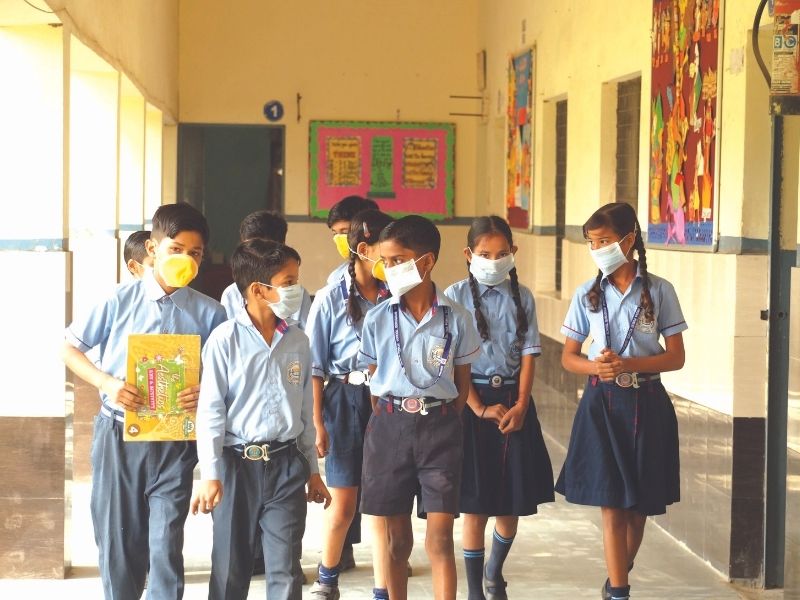
With the worst of the Covid-19 pandemic and its Delta and Omicron variants which disrupted industry, business and commerce to the extent that the Indian economy contracted by an unprecedented 7.6 percent in fiscal 2020-21 over, the economy is limping back to normal with GDP forecast to grow by 8.2 percent in the year ending March 31, 2023. The damage in terms of 5.12 lakh lives lost hasn’t been catastrophic, although that number is widely believed to be an under-estimate. Moreover, even if the number of lives lost is ten multiples of the official figure, it is still well short of the 18 million lives lost during the Spanish flu pandemic of 1918-20.
Yet even though the damage inflicted by Covid-19 in terms of economic output and lives and livelihoods lost has been well managed by the Central and state governments — 90 percent of the adult population has been double-jabbed by anti-Covid vaccines — there’s little awareness, let alone alarm, about the disruption in the country’s education system. From pre-primary schools to universities, it has been under strict lockdown for 82 weeks barring a few brief insignificant re-opening of campuses in some states.
Although your editors have been stridently advocating reopening schools and all education institutions for over a year and had published a detailed cover story last July titled ‘Why Schools Should Open Right Now!’ (educationworld.in/why-india’s-schools-should-open-right-now/), neither the government nor the influential urban middle class, paid any heed. Our main arguments were that several authoritative research studies indicated that children are rarely at risk of contracting severe illness from the Covid-19 virus, and that schools operating at 50 percent capacity with students attending on alternative days while maintaining strict Covid protocols would mitigate learning loss, especially among youngest children.
[userpro_private restrict_to_roles=administrator,customer]
Evidently, these and other arguments failed to resonate with the political class countrywide which preferred to err on the side of caution in the matter of child safety. The political fallout of children contracting the dread virus in under-provided and ill-administered government schools was judged too huge. Therefore for purposes of parity, private schools were also ordered to lock down. Evidence provided in extenso by your editors testifying that schools in several Western countries which were locked down in the immediate aftermath of the pandemic were quickly reopened, cut no ice. For instance, in France primary-secondaries were shuttered for a mere 12 weeks during the past two years; in the UK for 27 weeks; in Germany for 38 weeks and in Sweden, they didn’t shut at all. Even in the US, which was hard hit by the pandemic and suffered 9.3 lakh deaths, schools were ordered to be shut down for an average 71 weeks and in China where the virus originated, for 27 weeks. It’s pertinent to note that none of these countries reported a significant number of abnormal hospitalisations of children or mortality due to Covid-19.
The only explanation for the exaggerated caution displayed by the Centre and states in ordering the world’s most prolonged closure of education institutions is that politicians and bureaucrats aka the neta-babu brotherhood, are only too well aware of the infrastructure deficiencies and administrative lacunae of the country’s 1.2 million government schools. Such neglect makes observance of standard Covid safety protocols — distancing, hand-washing, toilet hygiene — impossible in state schools. Therefore the countrywide shutdown.
In this connection, the country’s influential, educated urban middle class is not blameless. Ill-informed and unaware of the response of other countries and expert domestic opinion on the issue — the vast majority doesn’t read EducationWorld — they swallowed self-serving official opinion on the dangers the virus posed to children. Simultaneously they reposed too much faith in ICT technologies proclaimed by newly-promoted edtech companies to deliver as good — and even better — curriculums and primary-secondary education to children learning from home. However, latterly several authoritative studies (Unicef’s Education from Disruption to Discovery (2021) and of Azim Premji University) have reported that not only is online education not as effective as in-class, in-person learning, but children also suffer loss of peer learning, socialisation skills, as also considerable psychological and mental damage when they are cooped up learning from home.
Unsurprisingly, edtech companies touting the advantages of ICT-enabled home learning overlooked the reality of the country’s dismal housing stock — under neta-babu socialism, en masse housing mortgage loans were permitted as late as mid-1990s. With the average Indian home covering a floor area of only 494 sq. ft, children were at greater risk of contracting the virus at home than in school.
Nor was this reality highlighted by the compromised academy or over-hyped media. Undoubtedly for children in the vast majority of households in the lower half of the country’s iniquitous socio-economic pyramid, on-campus schooling is a safer option than learning from home. Fortunately in recent weeks, a broad consensus has emerged that children should be back on campuses and learning in class.
However, it’s pertinent to bear in mind that following the most prolonged lockdown of the education sector of any major nation worldwide, the world’s largest cohort of children and youth estimated at 500 million has suffered huge learning loss and has a steep mountain to climb to make good the lost lessons of the past two pandemic years. The official attitude seems to be that it will soon become education as usual when classes resume in the post-pandemic era.
Yet informed educationists are unanimous that a carefully planned remedial national education strategy is required to make good the learning loss of primary-secondary students in particular. In the pages following we propose 10 solutions for children back in school to recover lost learning in the wake of the unprecedented lockdown of education countrywide for over 700 days.
Design and implement robust remedial education programmes
Regrettably, despite governments around the world implementing remedial learning programmes since the first wave of the Covid-19 pandemic in 2020, India’s Central government showed no urgency in formulating a national learning recovery programme. Belatedly, last month (February), after an 82-week nationwide lockdown of all education institutions, the Union ministry of education has written to 28 state governments to introduce “remedial interventions” to bridge children’s learning gaps. The learning recovery plan includes suggestions to improve teacher training, upgrade ICT facilities, measure children’s learning attainments and introduce customised learning interventions.
Meanwhile, a field research study titled Loss of Learning During the Pandemic (2021) of the Bengaluru-based Azim Premji University which tested 16,067 children in 44 districts of five states of the Indian Union, found that 92 percent of children in all classes have lost at least one specific language capability, while 82 percent have lost mathematical ability acquired in the previous year.
After the first wave of the pandemic, the responsibility of reopening and shutting schools as also designing and implementing learning recovery programmes devolved upon state governments. Therefore they need to make substantial budgetary provision for remedial education and learning recovery. Moreover, hard pressed state governments need to mobilise not just monetary resources but employ highly qualified academics to design and implement robust remedial education programmes to make good children’s unprecedented learning loss.
“With children out of school for almost two years, bridge courses of three-four months won’t be sufficient. They need at least a year-long bridge programme to recover age-appropriate learning levels. In Karnataka, we have recommended a year-long learning recovery programme, for which intensive teacher training is vital for success. State governments need to urgently invest money and expertise in remedial education programmes to begin the recovery process,” says Prof. B.S. Rishikesh, head of the Hub for Education, Law & Policy at Azim Premji University, Bengaluru.
A more radical solution proposed by EW editors is for government to declare 2021-22 as a zero academic year. This means that in the new academic year 2022-23, all schools and children — especially in government schools — will follow the 2021-22 syllabus and curriculums (see https://www.educationworld.in/declare-2021-22-zero-academic-year/). Although parents of children in private schools — especially in the Top 3,000 rated and ranked annually by EducationWorld, which fairly smoothly switched to digital online teaching-learning during the pandemic lockdown — are unlikely to favour this proposal, the Central and/or state governments can, and should declare 2021-22 a zero academic year for government schools.
Prioritise teacher training and development
Poor quality teacher training and development is the Achilles heel of Indian education. The country’s 10,000 degree dispensing B.Ed colleges — most of them in the private sector casually certified by NCTE (National Council for Teacher Education) — are infamous for their outdated curriculums, poor infrastructure and encouragement of rote learning pedagogies. With uninterrupted corruption in recruitment of government school teachers for over half a century, a Teacher Eligibility Test (TET) was introduced in 2011 for in-service and aspirant teachers with a five-year window. However, with a mere 8-10 percent of teachers passing TET annually, the time window has been extended indefinitely.
Nevertheless, the successful switch of a large number of private schools to online learning and general acceptance of ICT-enabled learning within the teachers’ community and the general population during the pandemic, provides a great opportunity to mass train teachers to use digitally-enabled hybrid teaching-learning pedagogies in classrooms.
Regrettably, there’s not even been lip service from government and policy formulators — the Union Budget 2022-23 made no mention of teacher development — to this vitally important prerequisite for radically altered post-pandemic classrooms.
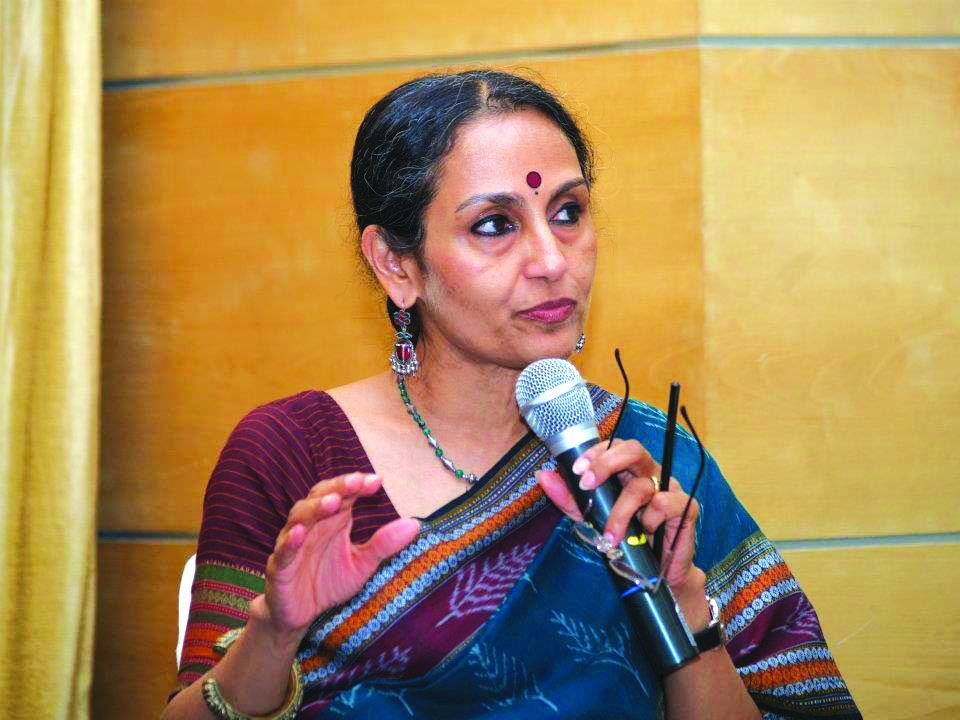
Maya Menon
“The pandemic has highlighted the urgency of providing the country’s 9 million school teachers sustained professional training and emotional support to enable them to deliver quality education in their classrooms. My prescription for the post-pandemic era is for government and private schools to ensure that all teachers receive 50 hours of professional development training annually as recommended by NEP 2020. The training programme should be designed after taking the post-pandemic learning needs of children and professional gaps of teachers into consideration. The curriculums of our B.Ed colleges need to be overhauled in light of the lessons learnt during the pandemic. We also need special teacher courses on managing learning during emergencies to ensure the mental health and well-being of children for understanding and addressing learning gaps and designing synchronous and asynchronous lessons,” says Maya Menon, the celebrated founder-director of The Teacher Foundation (estb.2002) which offers teacher training development services to government and private schools (88,000 teachers trained during the past 20 years).
Provide loans/concessional credit for budget private schools
India’s estimated 400,000 budget private schools (BPS), which provide affordable (Rs.7,000-25,000 per year) English-medium education to a staggering 60 million children, have been hardest hit by the prolonged closure of schools. BPS are the sole option of lower middle and working class households fleeing dysfunctional government schools defined by poor infrastructure, chronic teacher absenteeism, vernacular-medium education and dismal learning outcomes. But because of forced closure and unpaid tuition fees following contradictory fee deferment directives issued by state governments during the lockdown, even as these directives mandate payment of salaries and online education, they are in deep distress. According to the Delhi-based National Independent Schools Alliance (NISA), which has a membership of 60,000 affordable private schools countrywide, over 10,000 BPS have shut down across the country in 2020-22.
A great injustice meted out to the country’s BPS is that despite numerous appeals to the prime minister and finance minister, they have been excluded from the list of MSMEs (micro, small and medium enterprises) eligible for government credit guarantees and concessional loans during the pandemic. This despite their providing employment to 2 million teachers and schooling 60 million children.
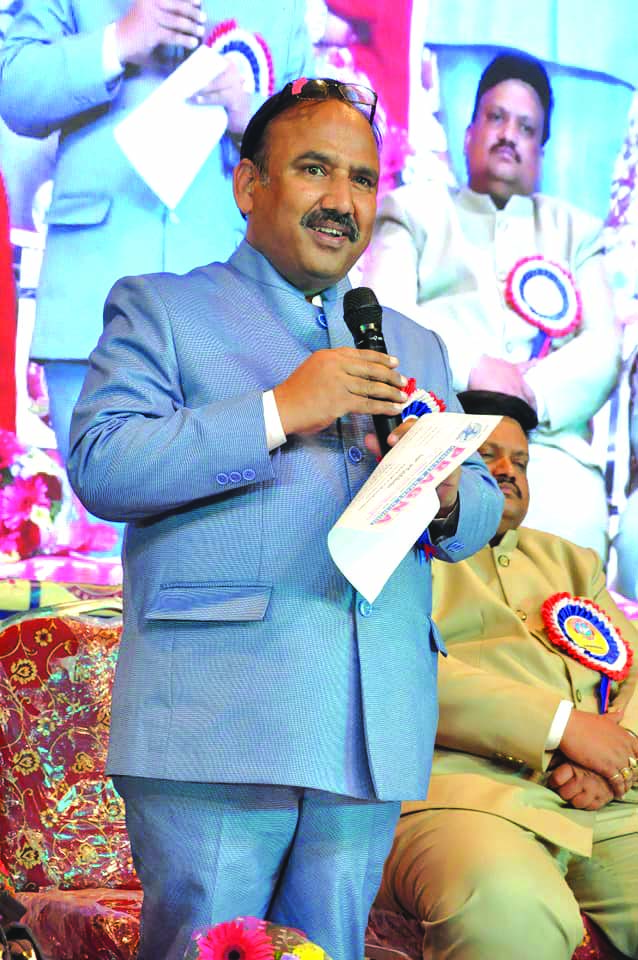
Kulbhushan Sharma
“The country’s budget private schools are in dire straits from which they will take many years to recover. NISA’s two major demands are: the Central government should create a BPS Finance Corporation to advance loans at 5 percent to enable budget private schools to recover and improve quality of education, and secondly for the transport ministry to extend the fitness certificates of school buses by two years,” says Kulbhushan Sharma, president of NISA.
Focus on foundational learning
Following over a decade’s sustained advocacy by EducationWorld, the National Education Policy (NEP) 2020 has accorded high priority to early childhood care and education (ECCE) and reconfigured the country’s 10+2 education system into a 5+3+3+4 preschool to class XII continuum.
However, during the 82-week Covid pandemic-induced closure of education institutions, pre-primary aka preschool children have suffered most as parents pulled their infants out of school because of widespread belief that they are highly vulnerable and online education is harmful and ineffective for youngest children. As a result according to estimates of the Early Childhood Association of India (ECA, estb. 2010), 20,000 private preschools — mostly promoted by women entrepreneurs — went out of business. Moreover, 1.4 million government anganwadis — which essentially provide nutrition to lactating mothers and newborns of low-income households, and rudimentary ECCE to infants — were shut through 2020-21 and 2021-22 resulting in 85 million children being deprived of free-of-charge mid-day meals and early childhood education.
According to Dr. Swati Popat Vats, founder-president of ECA and a pioneer crusader for universal formal ECCE, the overwhelming majority of pre-primary children have been wholly deprived of foundational education during the past two years and have also “lost important socialisation and life skills”.
However in a refreshing and radical initiative, NEP 2020 mandates compulsory three years of ECCE and two years of primary learning christened ‘foundational literacy’ for all children countrywide. To this end, the Central government has launched a National Initiative for Proficiency in Reading with Understanding and Numeracy (NIPUN) Bharat Mission to make all pre-primary children proficient in foundational literacy and numeracy (FLN).

Shaveta Sharma-Kukreja
“NEP 2020 has accorded highest priority to universal acquisition of FLN skills for all children by 2026-27. The policy and NIPUN mission have created a very conducive environment for state governments to design and launch statewide FLN programmes. But for NIPUN Bharat to succeed, dedicated budgetary allocations for FLN programmes are required to enable investment in sustained teacher training, and towards setting up of project management units to bring dedicated focus to the mission and aid in its effective implementation,” says Shaveta Sharma-Kukreja, co-managing director of the Delhi-based Central Square Foundation (CSF, etsb.2012). Currently, CSF is supporting 12 state governments including Bihar, Gujarat, Odisha, Haryana, and Uttar Pradesh in designing and operationalising statewide FLN missions.
Liberalise & deregulate education sector
A theme song of EducationWorld since it was launched in 1999 on the eve of the new millennium, has been to cut red tape and liberalise and deregulate the education sector on the lines of industry liberalisation and deregulation of 1991, strenuously advocated by your correspondent from 1978 as editor of Business India and Businessworld — India’s first business magazines. The outcome was a great leap forward in India’s annual GDP, stuck in a rut of 3.5 percent per year for over 40 years to 7-8 percent per year, and emergence of a large middle class with unprecedented purchasing power and raising 400 million citizens above the poverty line.
Unfortunately, the rationale and logic of industry and business liberalization, which restored a larger legitimate role to private business and industry in the national development effort, has bypassed the education sector. The outcome is that the private education sector has become a happy hunting ground of shady businessmen focused on certifying children and youth with sub-standard formal qualifications, rather than of bona fide educationists and philanthropists. With the country’s 1.2 million government schools defined by crumbling buildings, high teacher absenteeism, pathetic infrastructure and rock-bottom learning outcomes, the world’s largest child and youth population has been continuously deprived of good quality education from pre-primary to Ph D. Moreover, with the entire middle class preferring private school education, top-ranked private schools are unable to meet demand as a result of which corruption has also crept into private education. (See EW cover story https://www.educationworld.in/12-uninterrupted-rackets-destroying-indian-education/).
“Despite excessive regulation of private schools because of pressing demand, an estimated 2,000 private CBSE/CISCE and 80-90 international schools are promoted every year. This number could easily double if the education sector is deregulated which would also force down tuition fees. In this connection, it should be noted that our neighbouring countries including Bangladesh, Nepal, Bhutan and even China, permit for-profit private schools and balance their public and private education very well. Moreover, with continuous exodus of children from government to private schools, there is a good case for government to lease public schools to private education providers to manage on the model of America’s highly successful charter schools. This model has worked quite successfully in India where airports and highways have been built by government and leased to private companies to manage. The truth is that government — especially state governments — have miserably failed to manage public schools efficiently,” says Dhirendra Mishra, promoter-director of the Raipur/Bengaluru-based Life Educare Pvt. Ltd, an education consultancy which has aided the promotion of 55 K-12 private schools countrywide.
Economists and media pundits advise that nations should never waste crises. The Covid crisis presents the Central and state governments a unique opportunity to implement long-delayed reforms in the education sector. If single-window clearance is given to private school promoters with the option to promote taxable for-profit, non-profit and charitable schools, education institutions of all types will mushroom at all price points and competition will drive down tuition fees. Moreover, if a large number of government schools are forced to shut down, a school vouchers scheme can be introduced for parents/children to enroll in schools of their choice. Nothing but good can flow from the overdue liberalisation and deregulation of Indian education.
Provide better infrastructure, sanitation and healthcare in government schools
A truism that post-independence India’s omniscient central planners and educationists forgot is that schools have to be comfortable and attractive institutions to draw and inspire children. While private school managements have grasped this reality, the educracy that manages and monitors government schools have not. Therefore to this day, government schools — especially the great majority of primary-secondaries run by state governments — are defined by ill-constructed buildings, deficit of libraries, laboratories and lavatories and multi-grade teaching because of widely tolerated teacher truancy, despite the fact that government school teachers are very well remunerated in comparison with their private school counterparts.
Little wonder there is a continuous flight of children to private budget schools. According to Prof. Geeta Kingdon, professor at the Institute of Education, University College, London, the average number of children in (state) government schools has been reduced to a mere 34.
Quite clearly state governments which have thus far been laid back about primary-secondary education and have permitted all sorts of rackets related to issuance of NOCs (no-objection certificates), various licences and permits, textbooks writing and printing, teacher appointments and forcing their dominant languages as media of instruction (see https://www.educationworld.in/12-uninterrupted-rackets-destroying-indian-education/), need to get their act together and make a genuine effort to raise resources to improve the infrastructure of their schools.
Inevitably with most states running budget deficits, the excuse of paucity of funds is routinely advanced. However, there is considerable scope for initiatives such as the ‘Million Memorial Libraries Now’ project launched by EducationWorld in 2013. Under this project, an individual or family contributes a mere Rs.5 lakh to establish a modest library in a government or NGO school to commemorate a dearly departed parent or family member. After failing to persuade several government schools to accept this donation (and responsibility), in 2016 your editor and siblings established the Malati and Vinoo Thakore Memorial Library in the Hebbal (Bengaluru) primary-secondary of the Parikrma Humanity Foundation.
Unfortunately, despite considerable publicity, this initiative failed to inspire the country’s hard-hearted middle class to follow the example. However, this library is a live model for other small-scale philanthropists to emulate and replicate. Moreover, there are numerous options available to state governments to involve corporates and NGOs which are ready, willing and able to contribute to the upliftment of government schools in their states. But for this to happen, states have to make a determined effort to co-opt and/or regulate the educracy which is a major stumbling block.
Registered way back in 2003 by Shukla Bose, at one time the most well-remunerated woman CEO in India, over the past 19 years Parikrma Humanity Foundation (PHF) which runs four free-of-charge K-12 schools for 2,000 children of slum dwellers in Bengaluru, has developed a tripartite model involving the state government, NGOs and enlightened corporates to upgrade government schools.
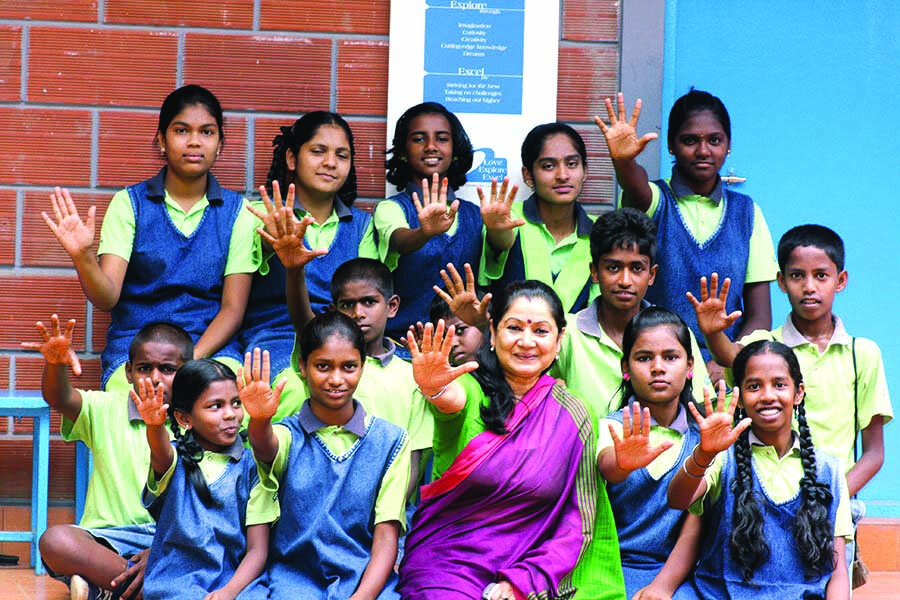
Parikrma Humanity Foundation’s Shukla Bose, along with her children
“Our first intervention with government schools began in 2018 when our Parikrma Education Transformation Centre provided training to 2,500 teachers in several urban government schools. Having observed the impact of our training the state government invited us to help in the overall upgradation of several of their schools. Under this arrangement, we adopted four government schools in Bengaluru and upgraded them with the financial support of corporates. Under this programme, our latest experiment with Ajax Engineering Ltd, PHF and the government, is to develop a model government school incorporating the reforms proposed by NEP, 2020 — to translate policy into practice and research into reality. The results of this initiative are very satisfying. Enrolment has increased by 40 percent and we have been able to win the trust of the parent community. We have also introduced art, sports, psychological counselling apart from experiential learning of regular subjects. We have succeeded in winning the trust and cooperation of government school teachers to enable them to adopt new teaching-learning pedagogies. I believe it is possible and necessary to upgrade and develop government schools under this tripartite model,” says Bose.
Boost ECCE, anganwadis and mid-day meals
A subject on which EducationWorld can derive legitimate pride for having moved the needle of public policy is early childhood care and education (ECCE). After your editors staged over a dozen national and international ECCE conferences and introduced the annual EW India Preschool Rankings in 2010, the critical importance of professionally administered pre-primary education — an area of darkness in Indian education — impacted government and the public. To the extent that on the recommendation of the K. Kasturirangan Committee, the National Education Policy 2020 has incorporated five years of ECCE into the new formal 5+3+3+4 school education system. This means that five years of pre-primary education has become compulsory for all children under the Right of Children to Free & Compulsory Education (RTE) Act, 2009. This also translates into the country’s 1.6 million Central government-promoted anganwadi centres (AWCs) — essentially nutrition centres for newborns and lactating mothers — being transformed into pre-primaries obliged to dispense formal ECCE.
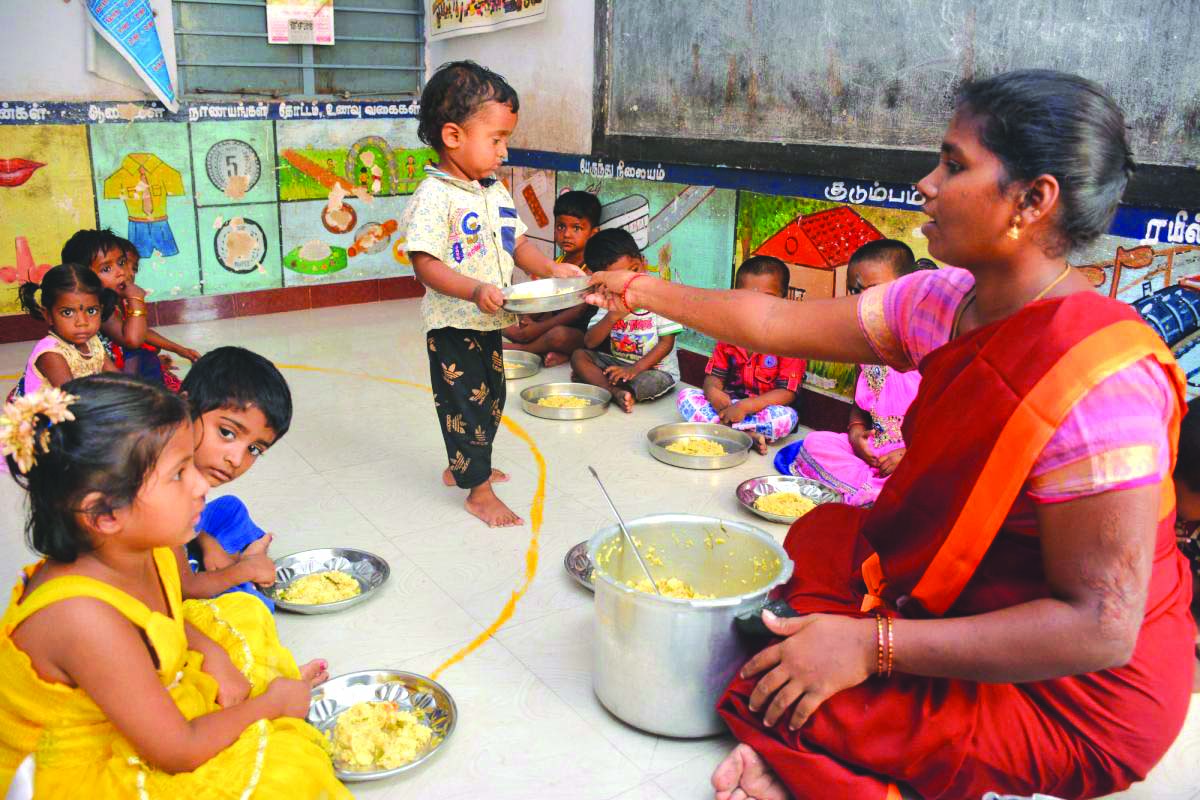
Anganwadi centre
However, it’s important to note that the country’s 1.6 million AWCs run jointly by the Centre and state governments accommodate only 85 million of the 164 million children in the 0-5 age group. Therefore, a huge national effort is required to accommodate the estimated 80 million children in the 3-7 age group to whom the State is obliged to provide free and compulsory ECCE under NEP 2020.
How and when required resources for investment in ECCE-cum-primary education, described as ‘foundational literacy’ in NEP 2020, is for the nation’s globally renowned economists and pundits to figure out, though annually while commenting on the Union Budget, your editors have been providing a schema which has not elicited any response for or against (see pg.45). Yet it is reassuring that while presenting the Union Budget 2022-23 finance minister Nirmala Sitharaman promised to upgrade 200,000 AWCs christened saksham anganwadis described as “new generation anganwadis that have better infrastructure and audio-visual aids, powered by clean energy and providing improved environment for early child development”. In line with this, provision for the free mid-day meals scheme and AWCs has been increased by 1.3 percent to Rs.20,263 crore.
Increase annual expenditure on education to 6 percent of GDP
Fifty-five years ago a high-powered commission of academics chaired by Dr. D.S. Kothari, chairman of the University Grants Commission, recommended that annual expenditure on education (Centre plus states) should be “at least 6 percent of GDP”. This was reiterated by the National Education Policy 1986 revised in 1992, the Subramanian Committee (2016) and the Dr. K. Kasturirangan Committee (2018). Moreover, ab initio since EducationWorld was promoted in 1999 with the mission to “build the pressure of public opinion to make education the #1 item on the national agenda,” your editors have been urging the Centre and states to raise annual outlays for diligently educating the world’s largest child and youth population to encash the country’s demographic dividend. All to no avail. Since independence the national outlay for education has averaged 3-3.25 percent of GDP with otherwise spendthrift governments of all hues and stripes at the Centre and states foolishly ignoring our advice to accord top priority to developing our abundant and high-potential human capital.
The consequences of this open, uninterrupted and continuous neglect of human capital have been disastrous. Contemporary India whose witless leadership and middle class seriously entertain global super-power ambitions, hosts 300 million illiterate adults. Moreover because of administrative and governance neglect, 25 percent of well-paid teachers of the country’s 1.2 million government schools are absent every day. As a result of multi-grade ill-equipped classes, 56 percent of class V children in rural government schools can’t read class II textbooks or solve simple three digit division sums as repeatedly testified by the Annual Status of Education Report of the highly-respected Pratham Education Foundation. Unsurprisingly, of 260 million children who enrol in primary classes, only 35 million complete higher secondary school and 35 million are in higher education institutions, none of which are ranked among the Top 200 in the World University Rankings league tables of the authoritative QS and Times Higher Education.
As a result the productivity of Indian industry is several multiples below its foreign counterparts. It’s well-known that productivity of American and Japanese shopfloor employees is 10 x of their Indian counterparts and 5 x in China. Likewise, in the agriculture sector foodgrain per hectare yields in Punjab (India’s breadbasket state) are one-tenth and one-fifth of the US and China. Ditto in the services — especially government services — sector.
The root cause of these glaring productivity disparities is relatively poor quality foundational and higher education. Yet in your correspondent’s four decades in business and education journalism, one has never heard captains of India Inc — addicted to bleating for tax concessions — make a strong case for education reform. In this connection for the past decade while analysing the Union Budget, your editors have been publishing a schema for the Central government to raise Rs.6-8 lakh crore for investment in education and healthcare (see box p.45) for several years.
Although this schema has been sent to several finance and education ministers, reputed economists (including Swaminathan Aiyar) and industry leaders for comment and critique, we have never received a single response. Quite clearly, within the establishment and the selfish middle class there is no will to make small sacrifices for improving public education.
Provide digital devices & Internet connectivity to under-privileged children
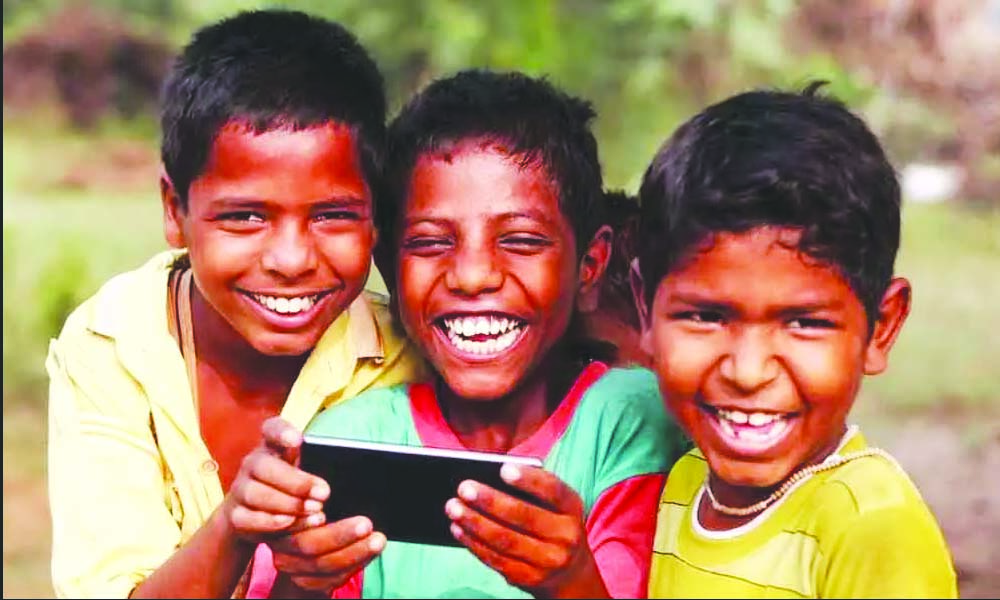
The Covid-19 pandemic has starkly exposed the gaping digital divide in Indian education. Since March 2020 when the country’s 1.5 million schools were ordered to close to check the spread of the virus, all education delivery moved to the online medium. Although upscale CBSE/CISCE/Cambridge and IB schools switched smoothly to online learning-from-home, with a mere 8 percent of Indian households having access to Internet connectivity and digital devices, learning effectively stopped for the majority of India’s 260 million children and youth in primary-secondary education, especially in rural India. According to the Annual Status of Education Report (ASER) 2020, a mere 11 percent of children enrolled in schools countrywide logged into online classes, and 21.5 percent accessed one-way video recorded classes.
During the past year, several recommendations have been made by educators and IT experts to bridge the digital divide. Among them: government to create a one-time digital education fund of Rs.100,000 crore in the Union Budget to purchase computer tablets for targeted children from bottom-of-pyramid households; government direction to all corporates to allocate their CSR (corporate social responsibility) funds to purchase and distribute digital devices to under-privileged children; government partnership with India’s prosperous IT sector to manufacture cheap digital gadgets for educational use; developing a digitally integrated ecosystem in rural areas with community wireless networks and information resource centres to provide online education; acceleration of the existing plan to provide fibre optic lines of 100 mbps in all panchayats across the country under the government’s BharatNet programme; provision of free Internet bandwidth to poor children to access online classes with internet service providers providing cheaper data plans for online education.
“Government needs to urgently prepare a plan to provide technology-enabled learning to children in three different scenarios — lockdown, hybrid and on-campus learning. For this to happen, ensuring universal access to digital devices, Internet and digital learning platforms is necessary. Government needs to urgently create a digital access fund to purchase digital devices and provide Internet connectivity to under-privileged children. Indeed, digital connectivity should be declared a public utility like electricity and water supply,” said Nooraine Fazal, co-founder and managing trustee of the highly-ranked Inventure Academy, Bengaluru, in an interview with EducationWorld in October 2020 and again in October 2021 (see https://www.educationworld.in/dear-prime-minister-why-no-pandemic-package-for-education/).
Launch National Child Mental Health & Well-being Programme

Dr. Kannan Gireesh
While the extent of academic learning loss suffered by India’s 260 million school-going children has been measured and documented in detail over the past two pandemic years, the damage to children’s mental health and well-being hasn’t been sufficiently assessed. Three pandemic waves and numerous lockdowns later, quite obviously India’s child mental health crisis has exacerbated.
Last month Dr. Samir H. Dalwai, development behavioural pediatrician at the New Horizons Child Development Centre, Mumbai, and treasurer of the Indian Academy of Pediatrics, told EducationWorld that “millions of children are showing signs of anxiety, depression, irritability, poor attention span, hyperactivity, sleep disturbances and post-traumatic stress disorder with younger children below six years showing regressive behaviour like clinging to parents, thumbsucking and bedwetting. We are facing a grave child mental health crisis.” (See https://www.educationworld.in/declare-2021-22-zero-academic-year/).
Within government there is some awareness that the country’s citizens who have survived the dread Covid-19 pandemic have suffered severe mental anguish and trauma. In the Union Budget 2022-23, Union finance minister Nirmala Sitharaman launched a national tele-mental health programme to provide 24×7 free counseling and care to people. The initiative will include a network of 23 tele-mental health centres of excellence, with the National Institute of Mental Health and Neurosciences (NIMHANS) as its nodal centre, and International Institute of Information Technology-Bangalore (IIITB) providing technology support.
However, educationists believe that government needs to establish a separate National Child Mental Health and Well-being Mission with state-level chapters. The mandate of this mission, which should solicit the assistance of NGOs and charitable organisations, should be to train teachers and school counselors to address pandemic-induced anxiety, restore children’s confidence and socialisation and life skills in order to transition smoothly to in-person schooling.
“As schools reopen cautiously, managements and teachers need to be trained to address and repair the mental, psychological and emotional damage children have suffered over the past two years. A National Child Mental Health and Well-being Mission will enable and facilitate formal school mental health programmes and training of teachers and counselors. I am confident that there is no shortage of NGOs and philanthropic organisations ready to partner with the government to restore children’s emotional and psychological well-being which must take precedence, as it’s the prerequisite of academic learning and success,” says Dr. Kannan Gireesh, a Chennai-based psychiatrist and founder of Live Life Education Pvt. Ltd, which has conducted “hundreds of online workshops” for teachers, students and parents on pandemic emotional damage issues.

Central Square Foundation prescription
The Delhi-based Central Square Foundation (estb.2012) in consultation with over 20 NGOs has drawn a list of 10 recommendations to make “schools children ready” during and after the pandemic. They include:
- Ensure equitable access to school. Reduce school dropouts and ensure demand for education is not lowered, by designing targeted interventions, especially for marginalized groups of children who have been disproportionately impacted by the pandemic
- Rebuild for safety and increase instruction time. Upgrade school infrastructure to abide by Covid-19 safety protocols and increase effective, in-person instructional time by reducing the number of holidays and freeing up teachers’ time from administrative tasks
- Slowly ease children back into school through readiness programs. Institutionalize school readiness programs for all children to gently re-induct them into social interactions while addressing their socio-emotional needs
- Focus on foundational learning. Prioritize attainment of foundational literacy and numeracy (FLN) skills for all children before they start learning other subjects
- Restructure what children are learning and how they are learning. Reduce the core curriculum to a minimal, viable set of learning outcomes and spread it over multiple years to ensure every cohort of students gets at least two to three years to compensate for missed and forgotten learning instead of a mere two to three months’ remediation period
- Identify where children are and meet them at their level. Leverage regular low-stakes assessments as a tool to identify the exact learning needs of each child and design teaching to meet them at their level
- Redefine the role of teachers and teacher mentors. Ensure teachers are re-oriented to their new role of supporting parents and volunteers to enable learning in addition to conducting classroom teaching. Teacher mentors need to be equally empowered to support teachers in transitioning into their new roles successfully
- Partner with parents as enablers of learning at home. Orient parents and support them in their new role as enablers of home learning
- Identify and mobilize community volunteers. Learning needs to be decentralized and taken to the communities by identifying and building local capacities to ensure learning continues despite disruptions
- Decentralize decision-making. Empower district and block officials to take localized and responsive decisions on school structures, instructional calendar, and opening and closing schools, to counter the impact of varying regional disruptions
Source: (Re)Build Back Better, CSF 2021
Also Read: Future of learning in post-pandemic era
[/userpro_private]












Add comment